The Woolworths Museum
A potted history of F.W. Woolworth
Adobe PDF downloadable and printable version of this page
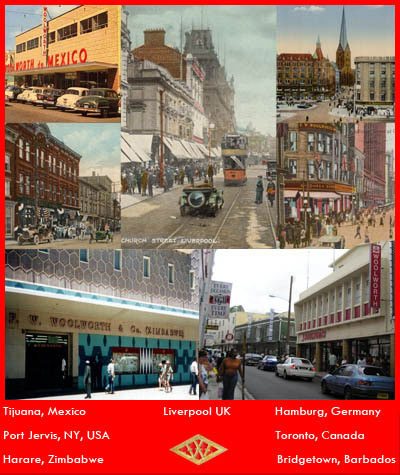
F.W. Woolworth was a mass market retailer, which established many of the standards which are still used in retail today. Supplier partnerships, loss-leading, supply chain efficiencies and strict, consistent branding, all had their origins at Woolworths.
In the early days the stores generated such riches that its Founder was able to put up the world's tallest building and pay for it in cash. Its shares were the gold standard of the markets, while to become a supplier was considered a licence to print money.
It created a consistent look around the world, while 'going native' to adapt to different communites and countries. UK shoppers considered 'Woolies' to be as British as fish and chips, while Americans called it 'the five-and-ten' sixty years after it abandonned its fixed prices.
But, having risen like a meteor, it faded into a peaceful retirement in North America in the 1990s, before falling like a stone in the UK in 2008. The 800-strong chain went from normal trading to complete oblivion in 41 days. Weeks later F.W. Woolworth GmbH of Germany became insolvent, though its administrators secured its survival and renaissance as a shop chain, rather than the website that now serves the UK.
There can be little doubt that if Frank Woolworth was starting out today it would be on the Internet, with its low costs and mass reach. But that is cold comfort for those who loved and cherished the stores in Britain, Canada and the USA. Fortunately the German company survives, along with some former British subsidiaries overseas in Zimbabwe, Barbados and the West Indies and a small chain in Mexico. But for most people these are a long way to walk for some pic'n'mix candy and a light bulb.
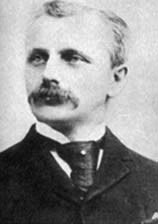
Frank Winfield Woolworth was born in Rodman, New York on 13 April 1852. At the age of fifteen he gave up life on his father's farm to seek his fortune working in a shop in Watertown. Despite studying commerce and book-keeping at night school, his boss, William Moore, found him useless as a Shop Assistant. Instead the young man took charge of display and stock management. One of his jobs was to set up a table of fixed price five cent goods, which proved such a hit that in 1879, with Moore's support, he branched out on his own, setting up one of America's early fixed price stores.
After a false start in Utica, New York, he relocated to the Amish country of Lancaster, Pennsylvania, opening a Great Five Cent Store on 21 June 1879. It was a great success and later the same year his younger brother, Charles Sumner Woolworth, joined as Manager of a second store in nearby Harrisburg. Ten cent lines were added in 1881, creating the first Five and Ten Cent store chain.
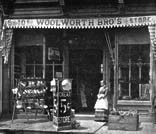
Over the next twenty years Frank invited relatives and co-workers from Moore's to join him, establishing a syndicate of five 'friendly rivals'. The chains operated independently, but carried his goods. The formula proved popular, allowing each pioneer to expand rapidly. The openings drew large crowds. As his buying power grew, Woolworth started to track products back to the source, offering cash payment to those vendors who were willing to drop their prices and sell direct. Many of the items came from Europe, where manufacturing was more advanced. After 1890 it became Woolworth's home from home.
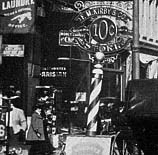
By 1905 other five-and-ten chains had opened in competition. Although these chains were much smaller and less successful, each of the syndicate members decided to incorporate his company, selling shares to friends and managers. This was done defensively as a safeguard against a hostile takeover, but also raised a lot of money, making the pioneers rich and allowing them to accelerate their opening programmes.
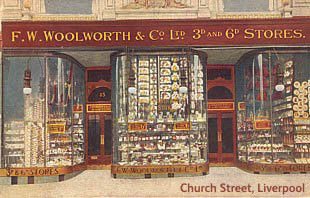 On 5 November 1909 Frank Woolworth opened his first store outside North America. 5¢ & 10¢ became Threepence and Sixpence for the branch in Church Street, Liverpool, England. Woolworth had toyed with the idea of opening in Britain ever since 1890 and took the plunge despite the reservations of his management.
On 5 November 1909 Frank Woolworth opened his first store outside North America. 5¢ & 10¢ became Threepence and Sixpence for the branch in Church Street, Liverpool, England. Woolworth had toyed with the idea of opening in Britain ever since 1890 and took the plunge despite the reservations of his management.
Frank hired his cousin, Fred, to lead the new venture along with three volunteers from New York State. To deal with resistance from the British press he also hired an Englishman, William Lawrence Stephenson, from a favoured supplier. The American parent put up £50,000 capital to finance the new British chain.
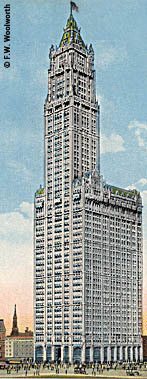 By 1912 the British subsidiary had already grown to twelve stores. Its momentum was so great that it was able to open stores using retained profit. Frank had already turned his attention to other projects.
By 1912 the British subsidiary had already grown to twelve stores. Its momentum was so great that it was able to open stores using retained profit. Frank had already turned his attention to other projects.
Work was nearing completion on his grandest scheme - the world's tallest building in Broadway Place, New York. He had commissioned the top architect Cas Gilbert, and had overseen the work personally, paying for it in cash. As the $13.5 m tower topped out in 1912, it was already in profit. Businessmen had flocked to take floor space in the landmark Woolworth Building that dominated the Manhattan skyline.
Also in 1912, the five friendly rival Five-and-Ten Cent Store chains joined forces. The fascias of S.H. Knox & Co., F.M. Kirby & Co., E.P. Charlton & Co., C. S. Woolworth & Co. and W. H. Moore & Son vanished from the Main Streets of the USA and Canada in the merger. The five men shared a bounty of $65m from the sale of shares. Each became a VP of the F. W. Woolworth Co. Frank engineered the deal and became the President.
By the outbreak of War in Europe, the British chain had opened 44 stores with many more in the pipeline. The infant resisted its parent's offer to send help from the USA as managers went away to war.
In 1917 the American company opened its thousandth store in palatial premises on New York's Fifth Avenue. In the same year the American President, Woodrow Wilson, invited Woolworth to take a Government role to raise funds after the USA joined the World War. The magnate launched a savings stamp scheme just weeks later, persuading rival dimestores to join him in selling them. He later funded victory parades for returning servicemen in many towns served by a Woolworth Five-and-Ten.
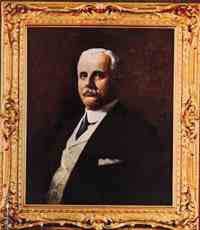 The final years of Frank Woolworth's life were filled with sadness. His beloved wife Jennie fell ill with 'the living death', which is called early-onset Alzheimer's today. His eldest daughter Edna died in tragic circumstances. She had been trapped in a loveless marriage to the financier Franklyn Laws Hutton. Frank's granddaughter, Barbara, later dubbed the "poor little rich girl" found her mum dead in bed.
The final years of Frank Woolworth's life were filled with sadness. His beloved wife Jennie fell ill with 'the living death', which is called early-onset Alzheimer's today. His eldest daughter Edna died in tragic circumstances. She had been trapped in a loveless marriage to the financier Franklyn Laws Hutton. Frank's granddaughter, Barbara, later dubbed the "poor little rich girl" found her mum dead in bed.
Woolworth suffered poor health as he got older. He was given to violent mood swings and often had to take to his bed for weeks on end. Nonetheless his death came as a great shock across the retail world. He passed away just three days after complaining of a head cold as he left his desk in New York. He died from septic poisoning from a tooth infection on 8 April 1919. He was 66 and had been preparing for the fortieth anniversary celebrations for his 1,200 strong chain. His brother, Charles Sumner Woolworth, became Chairman - a post he held with distinction until 1944, while the Company Treasurer, Hubert Parson, stepped up to become President.
Frank would have been pleased by one obituary reading: "He made his money not by selling a little for a lot, but by selling a lot for a little." He would also have been touched by arch-rival Sebastian S. Kresge's decision to close all of his stores for the funeral as a mark of respect.
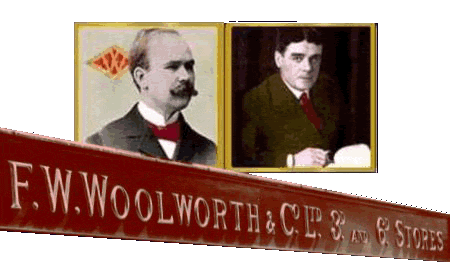 In 1923 the firm was rocked by another death, as Frank's cousin Fred, MD of the British subsidiary, passed away at just fifty-two years of age. He had overseen the opening of 150 highly profitable stores. He had a reputation for being firm but fair, setting high standards but also treating the staff generously, with paid holidays and outings to the seaside. A lively and active man, he suffered a stroke on a trip home to the USA and never fully recovered. He succumbed to a second attack six months later. His successor was the Yorkshireman William Stephenson, who (in his own words) "joined on the ground floor" before the first British Woolworth store opened.
In 1923 the firm was rocked by another death, as Frank's cousin Fred, MD of the British subsidiary, passed away at just fifty-two years of age. He had overseen the opening of 150 highly profitable stores. He had a reputation for being firm but fair, setting high standards but also treating the staff generously, with paid holidays and outings to the seaside. A lively and active man, he suffered a stroke on a trip home to the USA and never fully recovered. He succumbed to a second attack six months later. His successor was the Yorkshireman William Stephenson, who (in his own words) "joined on the ground floor" before the first British Woolworth store opened.
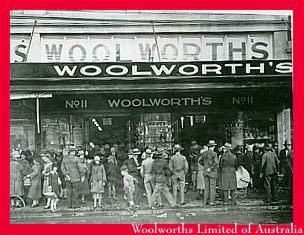 In 1924 a canny group of Australian entrepreneurs led by Mr. H. G. Christmas were looking for a name for their new 'stupendous bargain basement'. They cheekily applied to register the name F. W. Woolworth & Co. Ltd., in an attempt to cash in on the brand's pulling power, even though they were completely unrelated.
In 1924 a canny group of Australian entrepreneurs led by Mr. H. G. Christmas were looking for a name for their new 'stupendous bargain basement'. They cheekily applied to register the name F. W. Woolworth & Co. Ltd., in an attempt to cash in on the brand's pulling power, even though they were completely unrelated.
In-fighting between the British and American companies meant that neither raised its objection in time, allowing the venture to go ahead. Bitter legal battles in the High Court followed in the 1930s, after rumours spread of Antipodean plans to open an office in London. The Aussies had the last laugh. Unlike the Poms, they had the resolve to complete a move into food retailing in the Sixties. Today they are the nation's market-leading supermarket. A former subsidiary operates independently in New Zealand.
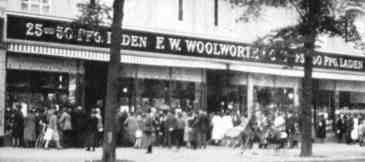
By the mid 1920s growth in the USA was slowing down. Rival dimestores had adapted to price inflation with fifteen cent lines. But the Woolworth Board was reticent to shake a proven formula, until they saw the early results from a new subsidiary in Weimar Germany in 1927. They had translated the formula to become the 25 und 50 Pfennig stores, roughly 10 and 20 cents, allowing a much broader range. The chain grew so rapidly that it had become self-sustaining before Hitler placed restrictions on foreign companies operating in Germany.
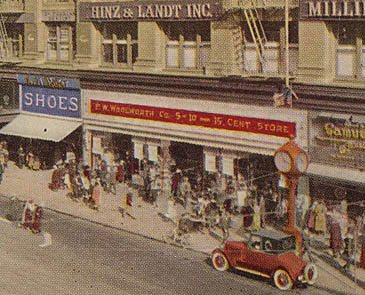
Buoyed by the German news, a 15 cent line was added after fiftieth birthday celebrations in North America in 1929. This re-energised the chain after its stock was among the heaviest fallers in the Wall Street Crash. Many investors were all-but wiped out by the collapse. Barbara Hutton's father Edwin had wisely sold her entire holding and put the money into gold just weeks before the crash.
The Company Treasurer, Byron Miller, hatched a scheme with the British MD William Stephenson. They reduced the American golden share and listed the subsidiary on the London Stock Exchange. The move gave the Threepenny and Sixpenny stores a measure of independence. It also funded a special dividend of $1.50 on each 25¢ parent company share. The move helped to save many investors. They rewarded Miller with the Presidency in the USA. Stephenson became Chairman in the UK.
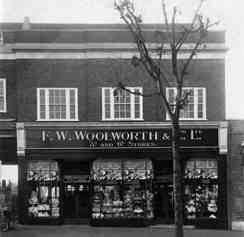 1934 marked two very different milestones in Britain and America. The UK firm was enjoying an unrivalled period of prosperity, opening a store every five days outside the Christmas season. A major celebration marked the opening of the 600th 'Woolies', which was a new-build London suburban store in Wallington, Surrey. Sales and profits had never been better.
1934 marked two very different milestones in Britain and America. The UK firm was enjoying an unrivalled period of prosperity, opening a store every five days outside the Christmas season. A major celebration marked the opening of the 600th 'Woolies', which was a new-build London suburban store in Wallington, Surrey. Sales and profits had never been better.
Meanwhile Stateside competition was hotting up. The Directors had to give in to the inevitable, facing up to a decision that had been postponed for too long. Rather than match the new 25¢ lines of their rivals, they opted to abandon the upper limit completely. They announced that Woolworth would remain a value store, but freed the Buyers to choose more aspirational products. Charles Sumner Woolworth told his biographer, company man J. K. Winkler, that he had abstained in the vote, unable to say 'yes' in his brother's memory, unwilling to say 'no' as a stockholder and a businessman.
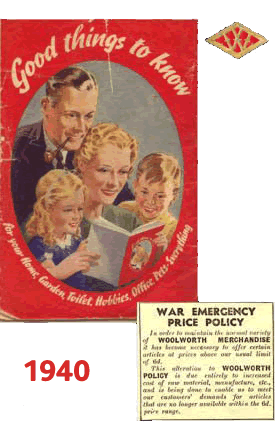
The British company went to lengths to maintain its sixpenny limit, asserting its buying power to make suppliers accept lower margins during the price inflation of 1938 and 1939. War forced a rethink as prices rocketed and cheap goods became hard to find. Officially the upper limit was dropped "temporarily".
As Britain and Canada went to war, the USA enjoyed a period of prosperity. New York recalled their American Directors from Britain and Germany, but all refused to leave. To show neutrality the Corporation donated to war relief in both countries, funding an orphanage near London and ambulances for Berlin.
In 1940 British staff raised 202,680 sixpences to buy a Spitfire to help the RAF. The four Directors matched them penny for penny and plane for plane. Lord Beaverbrook sent a thank you letter and a special plaque. He also agreed to the staff's request to name the planes Nix Over Six Primus, and Secundus. They were the first national assets ever to be named by a company.
Also in 1940, Germany invaded the Channel Islands of Jersey and Guernsey. The two stores there traded independently during the occupation.
America joined the war after Pearl Harbour, sending a big troop surge in the run-up to D-Day. Many Britons met their American Woolworth cousins for the first time, providing a 'home from home' for men 3,000 miles from a five-and-ten. A number of Woolies stores provided billets for soldiers waiting for the big day.
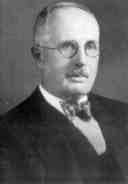 As the Allies marched into Germany in 1944, Company Chairman Charles Sumner Woolworth announced that he planned to step down because of failing health. He had opened his first Woolworth Bros. store in 1880. From 1885 to 1912 he led his own chain, C. S. Woolworth & Co., before joining forces with four 'friendly rivals' to form F. W. Woolworth Co. in the $65m merger. After his brother's death he had been appointed Chairman. He held the role with great distinction for 35 years. Despite his retirement, he continued to be an active member of the company. On his death in 1947 he had served the chain for a staggering 67 years, and yet today next to no-one has heard of him. By rights, he should be celebrated as one of the great retail pioneers.
As the Allies marched into Germany in 1944, Company Chairman Charles Sumner Woolworth announced that he planned to step down because of failing health. He had opened his first Woolworth Bros. store in 1880. From 1885 to 1912 he led his own chain, C. S. Woolworth & Co., before joining forces with four 'friendly rivals' to form F. W. Woolworth Co. in the $65m merger. After his brother's death he had been appointed Chairman. He held the role with great distinction for 35 years. Despite his retirement, he continued to be an active member of the company. On his death in 1947 he had served the chain for a staggering 67 years, and yet today next to no-one has heard of him. By rights, he should be celebrated as one of the great retail pioneers.
On 25 Nov 1944 tragedy struck the British company, as a German V2 rocket destroyed the large store in New Cross, London, causing the worst civilian casualties of any enemy action in the whole conflict. 168 people died.
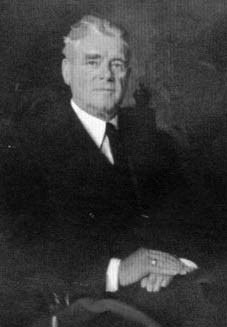 In 1945, following the Allied Victory, the English Chairman William Stephenson reflected on the sacrifices of the World War. He paid tribute to the 342 Woolies Managers and 1,963 other staff who had served King and Country in Uniform. In the final reckoning 145 lost their lives. He also praised the dedication of those who had kept the stores trading on the Home Front. 26 stores had been destroyed, 326 badly damaged and two had been occupied by the enemy out of a chain of 767 branches. He paid special tribute to 'Store 362' and to the 168 colleagues and customers who had fallen at its counters so tragically. He noted that the losses at New Cross were higher than across the whole of the rest of the company worldwide, including men under arms.
In 1945, following the Allied Victory, the English Chairman William Stephenson reflected on the sacrifices of the World War. He paid tribute to the 342 Woolies Managers and 1,963 other staff who had served King and Country in Uniform. In the final reckoning 145 lost their lives. He also praised the dedication of those who had kept the stores trading on the Home Front. 26 stores had been destroyed, 326 badly damaged and two had been occupied by the enemy out of a chain of 767 branches. He paid special tribute to 'Store 362' and to the 168 colleagues and customers who had fallen at its counters so tragically. He noted that the losses at New Cross were higher than across the whole of the rest of the company worldwide, including men under arms.
The German chain had also suffered terribly in the final years of the war, with many branches flattened, along with the parent company's state-of-the-art warehouse facility in Sonneberg. Ironically it had been annihiliated by the Bomber Command of the USAF.
Stephenson said that now the Corporation must rebuild for the future, declaring that he was excited about the opportunities that lay ahead. The 'English Mr Woolworth' had kept working well into his Sixties because of the war, and was keen to retire. He handed over the reins in 1948, but was frequently invited to provide Consultancy in New York and London throughout the Fifities.
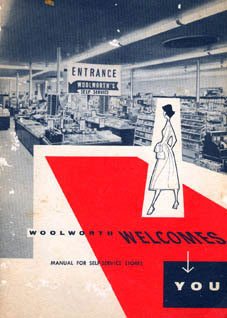 By 1950 every pre-war Buyer and Director had retired both in the United States and in Great Britain. Without the upper price limit it fell to a new generation to redefine the brand and to try to maintain the uniqueness that had taken Woolworth to the top of the market. The approach was very different on either side of the Atlantic.
By 1950 every pre-war Buyer and Director had retired both in the United States and in Great Britain. Without the upper price limit it fell to a new generation to redefine the brand and to try to maintain the uniqueness that had taken Woolworth to the top of the market. The approach was very different on either side of the Atlantic.
The Americans faced stiff competition as shopping habits changed. The cash-rich company responded with a massive investment programme, relocating many of the stores to Malls and converting them to self-service. These had new counter layouts and more merchandise, with high-priced items like electrical appliances. Margins were reduced, passing the savings on to the customer. New overseas stores were opened in Havana, Cuba, and evenPalestine.
In Britain it was a different story. Government austerity measures favoured Woolies. Unlike rivals it was able to import goods freely from overseas. Restrictions were based on quantities rather than prices, allowing the firm to buy high-priced items instead of sixpenny ones.
Without serious competition profits raced ahead. The Board became very conservative. It did not embrace self-service and opted to extend stores in-situ rather than relocate. A proportion of profits was retained for a mass-opening programme, which saw 250 new stores during the decade. But, ominously, controls weakened and stock levels spiralled upwards.
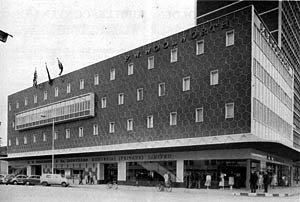 With plenty of money in the bank the British company went on a spending spree, upgrading the lighting across its mainland stores, adding small supermarkets in extra space and extending into emerging markets like Do-It-Yourself. It also began opening in the Commonwealth. In 1954 a branch opened in Kingston, Jamaica. Success brought further stores in the former colonies of Trinidad and Tobago, Barbados and the West Indies .
With plenty of money in the bank the British company went on a spending spree, upgrading the lighting across its mainland stores, adding small supermarkets in extra space and extending into emerging markets like Do-It-Yourself. It also began opening in the Commonwealth. In 1954 a branch opened in Kingston, Jamaica. Success brought further stores in the former colonies of Trinidad and Tobago, Barbados and the West Indies .
In 1959 it invested the princely sum of £1m to open a huge air-conditioned store in Harare, Zimbabwe (then known as Salisbury, Southern Rhodesia). It did not attempt to adapt the formula, instead exporting British goods and modelling the African layout on the store in the leafy Surrey town of Guildford, back in the UK.
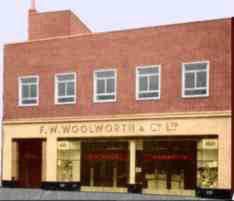 The British company celebrated its Golden Jubilee in 1959 with record profits. Despite being 52.7% American-owned, it was still the second largest stock on the London Exchange, outmatched only by ICI. Investors were paid a special celebration dividend.
The British company celebrated its Golden Jubilee in 1959 with record profits. Despite being 52.7% American-owned, it was still the second largest stock on the London Exchange, outmatched only by ICI. Investors were paid a special celebration dividend.
The 1000th branch had opened in Portslade, West Sussex on 22 May 1958. FWW boasted a shop in virtually every parade across the British Isles and the Republic of Ireland. Despite the bright and shiny appearance and the loyal customer following, these had changed very little over the previous fifteen years, save for stocking many more expensive items.
To marking the Jubilee, the dynamic American CEO Robert C. Kirkwood, who had risen from the stockroom to the boardroom, thanked the British for their contribution, but warned of tough times ahead. He urged the Board to adapt and change quickly. No-one listened.
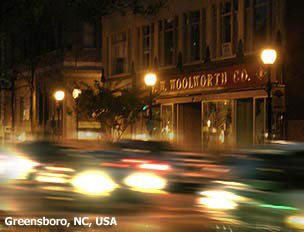 The CEO found himself embroiled in controversy back home in 1960, when civil rights protestors staged a sit-in at Woolworth's in Greensboro, North Carolina. In keeping with local custom, its lunch counter operated a 'whites only' policy, refusing to serve African Americans. Four students from the all-black North Carolina Agricultural and Technical College took exception. During the sit-in a local merchant helped them to compose a letter to Kirkwood demanding equal treatment.
The CEO found himself embroiled in controversy back home in 1960, when civil rights protestors staged a sit-in at Woolworth's in Greensboro, North Carolina. In keeping with local custom, its lunch counter operated a 'whites only' policy, refusing to serve African Americans. Four students from the all-black North Carolina Agricultural and Technical College took exception. During the sit-in a local merchant helped them to compose a letter to Kirkwood demanding equal treatment.
Kirkwood had already given his Store Managers the discretion to abandon the segregation policy. It was agreed that symbolically black members of staff would be served first, and then the protestors. The Greensboro Times reported 'They came as individuals and they were served as individuals. The sky did not fall.' The shop has been preserved. It marks a long overdue recognition that all men are born equal. At last the everyday store really was for everyone.
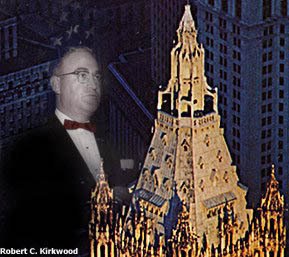 Kirkwood was a visionary leader. He believed passionately that the chain must embrace big changes in order to survive. He reshaped the Company. Some of his actions have helped to sustain the brand into the 21st century, continuing to pay dividends to shareholders. Others later contributed to the disintegration of the Woolworth store chains on both sides of the Atlantic.
Kirkwood was a visionary leader. He believed passionately that the chain must embrace big changes in order to survive. He reshaped the Company. Some of his actions have helped to sustain the brand into the 21st century, continuing to pay dividends to shareholders. Others later contributed to the disintegration of the Woolworth store chains on both sides of the Atlantic.
The CEO had already moved many Main Street stores into Malls and Shopping Centers. The next step was bolder still. He launched a chain of much larger Woolco stores out-of-town. These offered a one-stop shop with plenty of car parking. The idea was partly inspired by Kresge's K-mart.
The first Woolco stores opened in Columbus, Ohio, USA and Hamilton, Ontario, Canada in 1962. Trading was mediocre, but the CEO held faith, opening 150 outlets by the end the decade. He borrowed money on backloaded mortgages to finance the move, expecting the format to gel long before these fell due for payment in the Eighties.
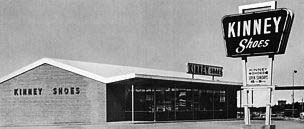 In another radical move, he started to diversify, buying businesses that he believed would complement the new Woolco Division. In 1963 the shoe giant G.R. Kinney was acquired. The retailer made its own products, and provided a steady supply of cheap, reliable footwear for Woolworth and Woolco. In 1969 the fashion chain Richman Brothers also joined the stable. Kirkwood hoped that adding new people and management skills would help to shake up Woolworth's narrow, conservative culture.
In another radical move, he started to diversify, buying businesses that he believed would complement the new Woolco Division. In 1963 the shoe giant G.R. Kinney was acquired. The retailer made its own products, and provided a steady supply of cheap, reliable footwear for Woolworth and Woolco. In 1969 the fashion chain Richman Brothers also joined the stable. Kirkwood hoped that adding new people and management skills would help to shake up Woolworth's narrow, conservative culture.
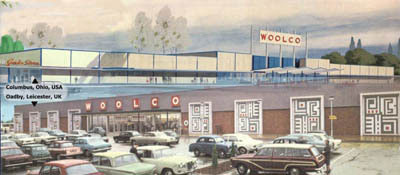 The UK board tried to ignore the CEO's suggestions. They considered Woolco inappropriate for the British market. The UK had lower car ownership and no shops out of town. Instead they extended some in-town stores to Woolco size.
The UK board tried to ignore the CEO's suggestions. They considered Woolco inappropriate for the British market. The UK had lower car ownership and no shops out of town. Instead they extended some in-town stores to Woolco size.
Kirkwood was not satisfied. He insisted that the subsidiary must give Woolco a go. He also pushed through a low-price own label brand, in place of the UK chain's range-by-range branding. Less controversially he encouraged the chain to computerise its supply chain and accounting, using software developed in the USA and already in use at a Central Accounting Office in Chicago, Illinois.
 Planning barriers meant that the first Woolco in Oadby, Leicester did not open until 1967. The own label was branded Winfield, the Founder's middle name, and hit the shelves in 1964. The Accounting Office and Warehouse was sited in Castleton, Rochdale in 1965, and became operational two years later.
Planning barriers meant that the first Woolco in Oadby, Leicester did not open until 1967. The own label was branded Winfield, the Founder's middle name, and hit the shelves in 1964. The Accounting Office and Warehouse was sited in Castleton, Rochdale in 1965, and became operational two years later.
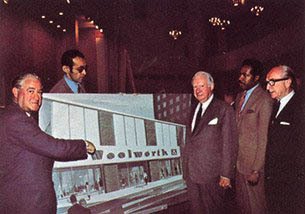 Under Kirkwood, Woolworth was confident and dynamic, but many of his ideas did not prove successful. The Woolco formula did not make sufficient profit to justify the set-up investment. To reduce costs Main Street leases were not renewed in locations that had an out-of-town Woolco. Many traditional F. W. Woolworth stores began to look outdated and run-down. A new Spanish subsidiary, opened in 1965 closed down a decade later, while Fidel Castro soon put paid to the branch in Havana. But a chain in Mexico prospered.
Under Kirkwood, Woolworth was confident and dynamic, but many of his ideas did not prove successful. The Woolco formula did not make sufficient profit to justify the set-up investment. To reduce costs Main Street leases were not renewed in locations that had an out-of-town Woolco. Many traditional F. W. Woolworth stores began to look outdated and run-down. A new Spanish subsidiary, opened in 1965 closed down a decade later, while Fidel Castro soon put paid to the branch in Havana. But a chain in Mexico prospered.
A new 'modern' corporate identity was introduced in North America as Woolworth prepared for its ninetieth anniversary in 1969. The red-front was replaced by a new light-blue logotype for new and refurbished stores. The styling was unpopular, and in the end the firm relented, retaining the logo but once again colouring it red.
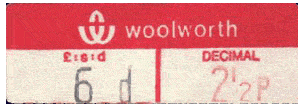 Britain had more pressing problems. The government announced in 1969 that the country would decimalise the currency in 1971. Woolworth could not afford to convert more than 10,000 cash registers and had to convert to self-service. The switch took six years. It consumed virtually every penny the firm had. During the same period inflation and industrial unrest hit profits, For the first time a few unprofitable stores were closed and sold to raise funds.
Britain had more pressing problems. The government announced in 1969 that the country would decimalise the currency in 1971. Woolworth could not afford to convert more than 10,000 cash registers and had to convert to self-service. The switch took six years. It consumed virtually every penny the firm had. During the same period inflation and industrial unrest hit profits, For the first time a few unprofitable stores were closed and sold to raise funds.
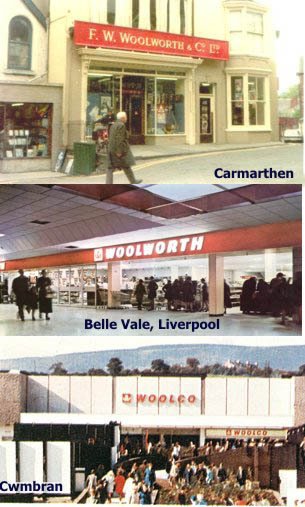 Before conversion to self-service many Woolworth stores looked quaint and old-fashioned. Even when a store was updated much of its range remained unchanged. In the 1970s sales were maintained by advertising on television and cutting prices.
Before conversion to self-service many Woolworth stores looked quaint and old-fashioned. Even when a store was updated much of its range remained unchanged. In the 1970s sales were maintained by advertising on television and cutting prices.
The British management looked increasingly inept during the 1970s. Progress with Woolco openings was slow. As first-mover they had to evangelise the idea of out-of-town shopping. The Local Authorities often said no. The management did not fight back. As a result Woolco UK never reached critical mass, even though its stores outperformed those in Canada and the USA.
The Board also seemed ambivalent about selling groceries, flip-flopping between rolling out a supermarket format and scaling it back. Their confusion seems to have stemmed from whether the goal was sales (extend food) or profit (withdraw it).
By 1978 Store Managers suspected that top bosses had lost faith in the Woolworth formula, because of a series of new initiatives. As well as Woolco, there were Shoppers World Catalogue Shops, a Burger Bar format and Footlocker shoes, a new US acquisition from 1975. There was even a new subsidiary in Cyprus.
The Board's competence was brought into sharp focus by a series of disasters during the decade. In 1971 a whole season's stock was lost when the four year old distribution centre burnt to the ground. Its sprinklers were not working. In 1972 the store in Belfast burnt down in the Northern Ireland troubles. It had no contingency plan. In 1973 the large superstore in Colchester also burnt down. Fortunately no-one was hurt, but no remedial action appears to have resulted from these events.
Disaster struck on 8 May 1979 when one of the largest stores, Manchester, burned down. Tragically eight customers and a member of staff died in the incident, which played out live on national television. The coverage showed that fire exits were locked and staff did not appear to have been trained. It took a number of years and a change of owner to recover the damage to the brand's reputation.
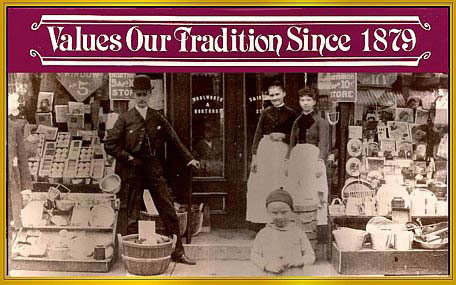
The parent company celebrated its centenary in 1979. The event was marred by a hostile takeover bid from Canada's Brascan Corporation. It highlighted the steady decline in returns over a twenty year period.
The management denied claims that cash was short, and promised good long-term prospects. The $35 a share bid was rejected by the Board, which narrowly won the day. The debacle revealed that, despite being the largest store chain in the world, Woolworth had become vulnerable. It prompted big changes during the Eighties.
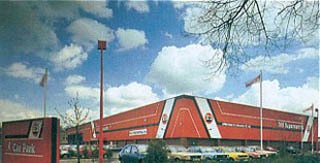 In 1980 the British Woolworth made its first acquisition, buying the B&Q Retail chain. Analysts believed the price of the out-of-town DIY stores group was too high, while the Board faced a backlash from Woolworth Managers for funding the purchase by closing and selling two major London stores.
In 1980 the British Woolworth made its first acquisition, buying the B&Q Retail chain. Analysts believed the price of the out-of-town DIY stores group was too high, while the Board faced a backlash from Woolworth Managers for funding the purchase by closing and selling two major London stores.
The Board responded with a PR charm offensive. It is believed that the campaign drew attention to the fact that Woolworth UK was undervalued, particularly after the B&Q purchase, and led to a buy-out bid from a group of entrepreneurs.
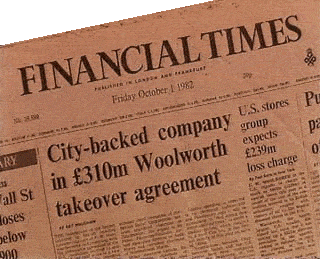 Despite the assurances given in the bid-battle, the US company needed cash. It agreed to sell its golden share of the British company to a local consortium of investors for £310m. The 'management buy-in' saw the firm change hands without the agreement of London stockholders, over the heads of the Board. The sale was completed on 1 Oct 1982.
Despite the assurances given in the bid-battle, the US company needed cash. It agreed to sell its golden share of the British company to a local consortium of investors for £310m. The 'management buy-in' saw the firm change hands without the agreement of London stockholders, over the heads of the Board. The sale was completed on 1 Oct 1982.
Weeks later the New York Board announced the closure of every Woolco in the USA. It said this resulted from the recession. The liquidation sale began in January 1983. The move reflected poor results throughout the life of the chain and allowed the real-estate to be sold to pay off the mortgages. The Canadian stores were more profitable and continued to trade.
Sam Walton later re-opened some of the stores as Wal*marts. The entrepreneur demonstrated that under the right management a white elephant can metamorphose into a cash cow overnight!
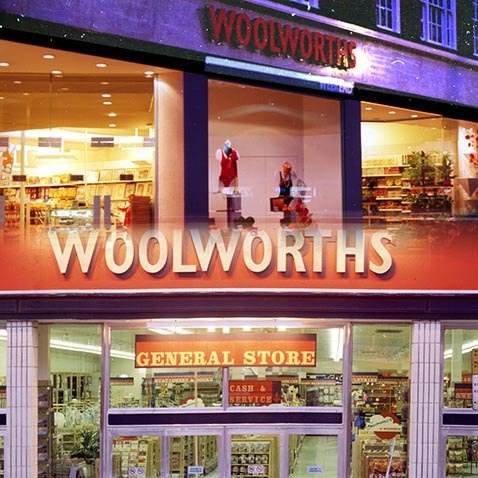 The new British owners initiated their own radical shakeup. The 250 best freehold stores were sold. Most were in London and other major cities. The Woolco stores and every Woolworth store in the Republic of Ireland were closed and sold. The overseas branches in the Commonwealth were sold cheaply to the local management.
The new British owners initiated their own radical shakeup. The 250 best freehold stores were sold. Most were in London and other major cities. The Woolco stores and every Woolworth store in the Republic of Ireland were closed and sold. The overseas branches in the Commonwealth were sold cheaply to the local management.
After paying off their backers, the new owners used the surplus to develop the B&Q out of town DIY subsidiary very rapidly and to acquire other UK businesses, including the Comet discount electrical chain and the Superdrug drugstore.
A new formula was applied to the surviving 750 High Street stores. The range was trimmed back to six areas where the chain had strong shares - Sweets, Toys and Stationery, Kids Clothes, Entertainment, Home and Garden, and Fashion Accessories.
Branches were given one of two bright new looks, the first for major towns and the second for local High Streets. By 1997 the chain was back in fashion and generating profits of £100m a year, allowing it to expand again,.The consortium had invested wisely. Kingfisher had became a respected international retail brand.
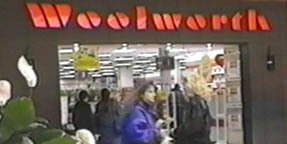
The picture was not so rosy in the USA, where Woolworth fell into steep decline after the closure of Woolco. As leases fell due stores were generally closed, with refurbishment activity kept to a minimum. In an attempt to revive the chain, 900 stores were closed in 1992 and another 1,000 in 1993. Richman Brothers was closed after the management failed to find a buyer. The goal of the restructuring was to release funds to restore the remaining metropolitan branches, principally in New York State, Pennsylvania and Florida where the chain still had critical mass and could perhaps be saved.
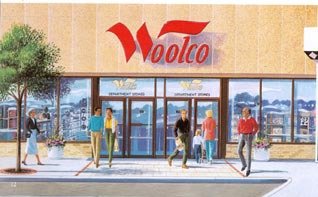
In 1994 120 of 160 Woolco Canada stores were sold to Wal*mart in 1994 and the other forty were closed. At the same time the remaining Canadian Woolworth stores closed their doors. Many later re-opened as branches of The Bargain!Shop (now known as TBS/Red Apple.
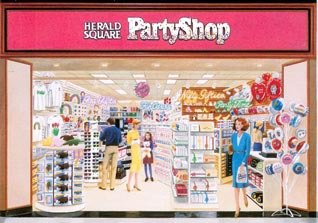
Between 1995 and 1997 the parent, ominously renamed Venator Corporation tested a number of new formats in Delaware, with good results. But in 1997 it reluctantly called time. It had decided that a dignified retirement was the best option, having found that it could get a safer and higher return from its newer fashion and shoe formats. Some of the remaining Woolworth stores converted to Footlocker, while others still stand empty and crumbling fifteen or more years after closing their doors for the last time.

To complete the American exit from variety store retailing, the successful subsidiary Woolworth chains in Germany and Mexico were sold to their local management for nominal sums in 1997.
 By 1999 the UK Woolworths parent Kingfisher had a strong reputation. The CEO seemed to have the Midas touch as he had built a huge empire which had pushed the share price ever upwards. Investors overwhelmingly endorsed his proposed 'merger of value champions', in which the group would merge with Asda, the UK's third largest supermarket. Detailed plans were published showing the benefits, particularly to Woolworths and sister company Superdrug, and to Asda. Just as the deal was due to complete Asda withdrew, accepting a better offer from the world's largest retailer, Wal*mart.
By 1999 the UK Woolworths parent Kingfisher had a strong reputation. The CEO seemed to have the Midas touch as he had built a huge empire which had pushed the share price ever upwards. Investors overwhelmingly endorsed his proposed 'merger of value champions', in which the group would merge with Asda, the UK's third largest supermarket. Detailed plans were published showing the benefits, particularly to Woolworths and sister company Superdrug, and to Asda. Just as the deal was due to complete Asda withdrew, accepting a better offer from the world's largest retailer, Wal*mart.
Commentators and major investors were angry, finding fault with many aspects of Group performance, and demanding a major shake-up. In the end the firm capitulated, putting Woolworths and Superdrug up for sale. The chemist was sold to Holland's Kruidvat, while Woolworths was demerged as a separate stock-market listed company. To make money on the deal all of its properties were sold and the new company started life with £ 200m of debt.
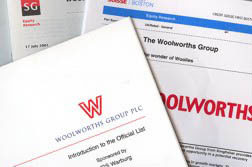 The long, drawn-out demerger process saw a series of Boardroom bust-ups. By the time the new Group launched it had a new management team, brought in from outside with little value retail experience. The new CEO Trevor Bish-Jones wooed the City to a plan to move upmarket, and expand the music publishing and distribution division. He decided to focus his attention on improving the largest stores, which were actually the least profitable, while leaving the smaller branches for a later date.
The long, drawn-out demerger process saw a series of Boardroom bust-ups. By the time the new Group launched it had a new management team, brought in from outside with little value retail experience. The new CEO Trevor Bish-Jones wooed the City to a plan to move upmarket, and expand the music publishing and distribution division. He decided to focus his attention on improving the largest stores, which were actually the least profitable, while leaving the smaller branches for a later date.
The formula centred on children, with larger displays of Toys and Clothes, music and DVDs replacing some of the traditional home ranges. The offer of sweets and pic'n'mix was trimmed back. Prices remained competitive but on a more up-market range.
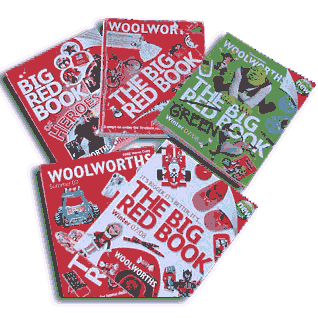 Between 2002 and 2007 weekly customer numbers fell steeply from 7m to 4½m, as loyal shoppers without children were driven away. The problem was compounded by intense competition from the major supermarkets, which diversified into the ranges carried by Woolworths, and undercut the prices.
Between 2002 and 2007 weekly customer numbers fell steeply from 7m to 4½m, as loyal shoppers without children were driven away. The problem was compounded by intense competition from the major supermarkets, which diversified into the ranges carried by Woolworths, and undercut the prices.
A series of acquisitions, paid for in cash, made the Group more dependent on music and video products, at a time when that market was in meltdown. Investors were assured that the wholesale division and publishing arms were both "world-class businesses", to balance the recovery story at Woolworths.
An attempt to stop the rot by launching a big book catalogue and expanding the chain's presence on the Internet was costly. Despite building sales to £70m a year and winning a 'best in world' award in 2006, the new venture would need time to take hold and become profitable.
Profits fell each year. The stores made their first loss in 97 years in 2005/6, although the other divisions helped the group to stay narrowly in the black.
 A value initiative in 2007 increased traffic and appeared to be turning the situation around. A consortium of international bankers was happy to refinance the chain, using the rare Asset-Based Lending model in the Spring of 2008. Shortly after it was signed Woolworths Group sacked its CEO of 6½ years and announced a change in direction. The banks were furious.
A value initiative in 2007 increased traffic and appeared to be turning the situation around. A consortium of international bankers was happy to refinance the chain, using the rare Asset-Based Lending model in the Spring of 2008. Shortly after it was signed Woolworths Group sacked its CEO of 6½ years and announced a change in direction. The banks were furious.
As a the global economic situation worsened, insurers withdrew their cover for Woolworths purchases, fearing that the wholesale operation was over-exposed to a downturn at its clients. This led to cash-flow difficulties. A request for additional funds was declined, and a proposed restructuring was rejected, forcing the chain into Administration. Just 41 days later, after 99 years and two months in the High Street, the stores closed their doors for the last time. With the exception of the bankers and the Administrator, everyone else, including many suppliers and all of the staff lost heavily in the collapse, which came to symbolise the credit crunch in the UK.

A fortnight after the last store closed, the Administrator, Deloitte LLP, announced it they had 'saved the brand'. The Woolworths name had been sold to highly respected Shop Direct Group and would be transferring on-line. The new woolworths.co.uk launched in the Summer of 2009 and prospered for a while, before being retired in favour of its parent's popular very.co.uk site. They sold on the brand name in 2024 to the German Woolworth Company.
The credit crunch also forced the German company to declare itself insolvent. Its administrator was able to find a white knight to salvage and relaunch a significant part of the company. Today Woolworth Ltd has regenerated, expanding to its largest ever 620 outlets in Germany, with around twenty more in neighbouring Austria and Poland. They remain true to the Founder's original vision of an ultra-low cost operation, selling principally own-label products at unbeatable low prices, with around 10,000 items for the Home, Stationery, and Fashions for all the family at prices that are hard to beat. They trade from medium-sized stores in larger towns and Cities across Germany, and continue to add around a hundred stores a year.They recently shared plans to expand progressively across Europe, and announced that they had acquired the rights to trade in Great Britain and Ireland. They hope to re-open in the British Isles in the medium-to-long term in keeping with their successful expansion plan.
At the time of writing there is also an independent F. W. Woolworth still trading in Bridgetown, Barbados, while the store in Harare, Zimbabwe still trades as Woolworths from its original premises as part of the larger department store chain of the same name in South Africa. Woolworths also trades profitably in Mexico as part of a larger convenience store group.
The original parent company, now known as Footlocker Inc, continues to trade successfully. It is the largest athletic shoe company in the world with more than 3,000 shops across the globe. In the UK there are a handful of locations, like Brixton, South London, where Footlocker operates from the spot that was once home to a Woolworth store. The former parent company, Kingfisher, remains the market leader in Do-It-Yourself retailing in the United Kingdom and France, with many interests around the world.